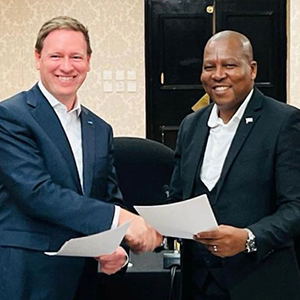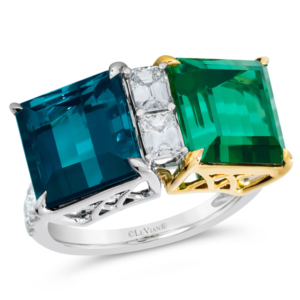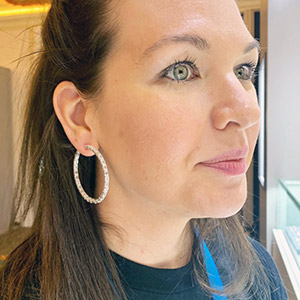
Following an often-bitter public squabble that both riveted and unnerved the diamond trade, De Beers and Botswana have reached an agreement in principle that includes a new 10-year sales deal and a 25-year renewal of the company’s diamond mining licenses when they expire in 2029.
The new pact increases the amount of diamonds that state-owned Okavango Diamond Company (ODC) can sell from Debswana, the mining company jointly owned by De Beers and the Botswana government.
Currently, ODC can sell up to 25% of Debswana’s production. The new framework calls for ODC’s share of Debswana’s production to immediately jump to 30%, increase to 40% in four years, and hit 50% by the contract’s final year, in 2033.
Paul Rowley, De Beers’ executive vice president of diamond trading, tells JCK the contract is a “win-win.”
“The win for us is the fact that there’s a continuity of supply to the industry. It has really relieved many people that this is not just a 10-year sales agreement, but, perhaps even more importantly, we have a 25-year mining lease. So that will be another 30 years of steady supply, and that’s great for everyone.”
Still, the new arrangement could hit De Beers’ bottom line. Currently Debswana sells its goods to Diamond Trading Company Botswana (DTCB), which is also a 50-50 partnership between De Beers and the government.
Both ODC and De Beers buy goods from Diamond Trading Company Botswana at a fixed percentage off what’s called their “standard selling value,” which is based on the De Beers price book. De Beers Global Sightholder Sales then sells its percentage of the diamonds to its clients at full price-book value.
Though De Beers isn’t getting zero for goods sold by the Botswana government (and vice versa), it won’t get as much as if it sold them itself. Okavango generally sells by tender, so it may get more for its goods than if they were sold by De Beers—though it’s possible in a bad market it might get less.
The wrangling over the percentage sold by ODC—which Botswana officials highlighted in a New York Times story one day before the contract was announced—wasn’t just about money, Rowley says, but “Botswana wanting to get more involved in the diamond value chain.”
Having access to one-half of Debswana’s supply will make Okavango a far bigger player in the industry. Rowley says he expects it to contribute to industry marketing through groups like the Natural Diamond Council (NDC).
“We’ve heard loud and clear they want to play their part, not just through their relationship with De Beers but also along the entire value chain, whether that’s through NDC or other initiatives,” says Rowley.
Emma Peloetlets, permanent secretary to Botswana’s president, Mokgweetsi Masisi, told state TV that the gradual phase-in makes sense from ODC’s perspective. “We will take it bit by bit, because if we just do that all at once without a proper plan about how to sell the diamonds, the price in the market would fall,” she said, according to Bloomberg.
Rowley says that while De Beers will eventually have fewer Botswana goods to sell, the company’s overall volume won’t necessarily decrease. “Ten years is a long time,” he says. “We’ll see [South African mine] Venetia come back strongly in that period of time, and we’re looking at other exploration opportunities in the future—and some of those, hopefully, the Botswana government will look to joint venture with us on.”
Regarding beneficiation, Rowley says that both De Beers and Botswana will probably continue to insist on bigger goods be cut in Botswana. “We sold just under $1.1 billion worth of goods into [Botswana] beneficiation last year,” he says. “It’s likely we will continue to look at supplying similar amounts into the future.”
One of the more surprising aspects of the deal is the creation of a Diamonds for Development Fund, meant to diversify Botswana’s economy. This will be seeded with an up-front investment by De Beers of $75 million, which could reach up to $750 million over 10 years. De Beers will be a member of the organization’s board of trustees.
“The fund is very much about, how does Botswana move beyond diamonds?” says Rowley. “Energy is a great [opportunity], tourism, agriculture and farming. It’s a great opportunity to create thousands of jobs.”
There have been signs that De Beers might be diversifying as well. The announcement of the deal came less than two weeks De Beers’ Lightbox brand started selling engagement rings—timing that some in the industry thought auspicious.
“The government of Botswana, and the governments of all our partners, were fully involved in the thinking behind what is a very small pilot,” Rowley says. “Lightbox is about making sure that the consumer understands the difference between [natural and lab-grown diamonds], and this pilot is a part and parcel of doing that.”
In April, De Beers cochair Bruce Cleaver suggested that De Beers’ decision to possibly invest billions in an expansion of Botswana’s Jwaneng mine was contingent on a successful conclusion to the negotiations.
Rowley says a final decision on any expansion is up to Debswana’s board, but adds, “We don’t sign a 25-year mining lease without the intention to invest.”
The joint communique announcing the deal was sent to JCK on July 1 at 12:25 a.m. Botswana time, less than half an hour after the two parties’ 2011 deal was set to expire. It said the new agreement was not finalized, so the two parties will continue to be governed by the terms of the most recent sales agreement.
But Rowley says this is more than another extension. “We have signed the main principles of this agreement. The extension is there to conclude the details. That we’ll do in the coming weeks, possibly months.
“The real drawing up of the contract takes a while,” he adds. “It does have to [be approved by the] Anglo-American board and shareholders and, likewise, from the Botswana government side, it will have to go through cabinet. But do I expect anything materially different from what we’re discussing today? No. We have dealt with the difficult areas that we wanted to get through, and there’s been compromise on both sides. That’s what negotiations are about, at the end of the day.”
The resolution to this drawn-out drama seems good for Botswana, yet De Beers’ majority owner Anglo American may not be thrilled with any result that reduces its profits, according to the Financial Times, (Anglo owns 85% of De Beers; Botswana owns 15%. That percentage will not change in this new deal.)
“The negotiations have raised uncertainty over the strategic value of the diamond miner for Anglo American,” said an article in the newspaper shortly after the deal was signed. “Berenberg analysts said last week that ‘Anglo American should question whether De Beers should remain in the group portfolio for a number of reasons,’ including the likelihood of poorer economic terms resulting from the negotiations.”
Rowley says that decisions made by Anglo American are “above my pay grade,” but that Anglo has “done nothing but support De Beers—through COVID, through market downturns, and through these negotiations.”
De Beers and Botswana’s partnership stretches back five decades. During the signing, De Beers’ new CEO Al Cook indicated the company would never take it for granted. “We at De Beers will never forget that it is a privilege to be the partners of the government of this great country,” he said. “It is a privilege; it is not a right.”
Top: De Beers CEO Al Cook and Botswana’s minister of mines and energy, Lefoko Moagi (photo courtesy of De Beers)
Follow JCK on Instagram: @jckmagazineFollow JCK on Twitter: @jckmagazine
Follow JCK on Facebook: @jckmagazine






